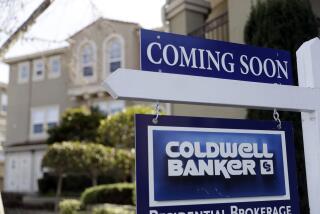Real Estate Deals Are True to Form
- Share via
If you think everyday life is filled with paperwork, wait until you try to buy or sell a home.
The now-basic eight-page real estate purchase contract is only the beginning.
There are lengthy statements disclosing any problems with the property being sold, pest control reports, and information about earthquakes and environmental hazards. Then there are the smoke-detector compliance forms, water conservation retrofit certifications, non-foreign affidavits, California withholding exemption certificates and loan applications requiring up to 40--or more--signatures.
Jon Douglas Co. even started charging a $250 “professional services” fee last year on top of the commission earned by the brokerage company. If Jon Douglas represents both buyer and seller, it charges $500 to cover paperwork costs and the expense of training agents in so-called risk management.
“Because the number of forms has grown so much, it takes more secretarial and administrative time to service our clients,” said Bernice Ross, the company’s executive director of training.
A decade ago, she recalled, real estate agents used a one-page purchase contract and just a few other forms. Now, the basic contract is eight pages and it is usually supplemented by more than 40 additional forms. Jon Douglas also has a two-page form that catalogues the completion and signature of all the other forms.
“It is extremely time-consuming to go all the way through the process,” Ross said. “It is a real headache.”
“A lot of the paperwork is overwhelming,” said Eric Shewfelt, director of Wilshire Escrow Co. in Los Angeles. “People can’t assimilate so much material. It’s just oodles and oodles of information.”
The extra paperwork has also contributed to confusion in the pricing of escrow services, Shewfelt said. Escrow companies usually charge a base fee of $200 to $300, plus $1.25 to $2.50 for every $1,000 of the sales price of the property changing hands through escrow. There are other fees that may be added for handling paperwork, though--such as sub-escrow fees charged by title companies, processing fees and administrative fees.
Loan packages that used to be just a few pages are now up to 55 pages, and they require 35 to 40 signatures and initials, Shewfelt said. And some lenders and loan brokers are being so picky that they want every signature to match. Shewfelt recalled one recent escrow where the buyers had to re-sign most of their paperwork because the lender thought that the wife’s signature on all the papers varied too much.
Having to process dozens of forms and make sure that they are all signed consistently has made the job of providing escrow services much more time-consuming, said Anne Burden, vice president and escrow manager of Stewart Title in Glendale. “I need more people to do less transactions.”
Today’s real estate transactions have also more specific time limitations for certain forms to be furnished and signed by a buyer and seller. It’s the job of real estate agents to make sure that all the paperwork is done properly and on time.
In practice, though, the escrow agents have to spend more of their time chasing paper.
Some of the lesser-known forms that have now become part of sales transaction include:
* Disclosures to buyers in the San Fernando Valley about the Metro Red Line extension and a Burbank-Glendale-Pasadena Noise Exposure map with a notice about airport noise.
* Seller’s Non-Foreign Affidavit. This form is filled out by U. S. residents and resident aliens so that proceeds from the sale will not be withheld for the Internal Revenue Service. Without this form--or a special buyer’s affidavit that the property is owner-occupied and under $300,000--10% of the seller’s proceeds must be withheld to potentially pay capital gains taxes to the IRS. This form was instituted to ensure that the IRS collected capital gains taxes from foreigners.
* A State of California Nonresident Withholding Exemption Certificate for Real Estate Sales. This Form 590-RE is similar to the federal version. More than 3% of the proceeds of a sale must be withheld from out-of-state sellers to satisfy the Franchise Tax Board.
* A declaration under penalty of perjury to be signed by property owners in certain areas with one acre of land or more. Sellers must sign and acknowledge that they have inspected and identified any oak trees on the property. Sellers must also agree to pay a fee to the Department of Building and Safety for any inspection required to verify the declaration.
* City of Los Angeles 9A form, which requires a $33.50 check to the city’s Department of Building and Safety, along with a declaration about smoke detectors, sliding glass-door impact hazard glazing and water conservation devices.
* City of Los Angeles Water Conservation Form Certificate of Compliance. This form must be filled out by the buyer, seller and a certified retrofitter, contractor or real estate agent. There is also a minimum $15 fee that must be paid to the city.
The bottom-line reason for the explosion of paperwork is that all the parties to a sale want to do their best to insulate themselves from liability, and federal state and local authorities want their rules obeyed, said Pat Fredericks, director of marketing for Coldwell Banker Town & Country, which operates four offices in Ventura County. “It’s a sad commentary on our time, but an absolute necessity.
“It’s an absolute nightmare when you are going through it,” Fredericks said, “but the paperwork is protection.”
More to Read
Inside the business of entertainment
The Wide Shot brings you news, analysis and insights on everything from streaming wars to production — and what it all means for the future.
You may occasionally receive promotional content from the Los Angeles Times.










